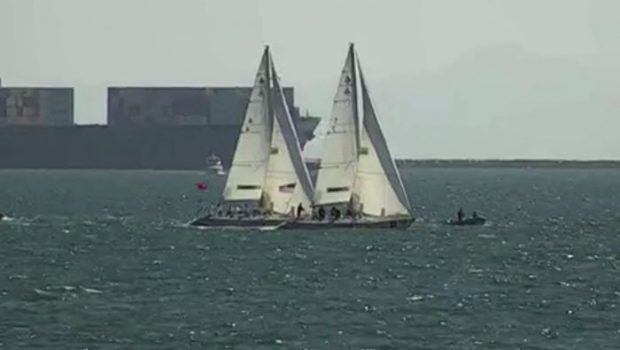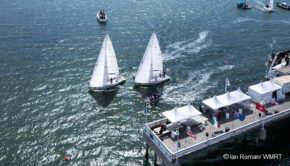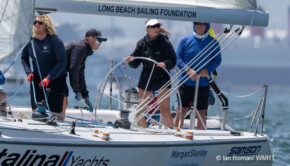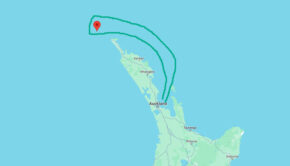Match Racing: A clever penalty to kill
Published on October 12th, 2021
As Boston Red Sox fans now celebrate their win of the American League Division Series over the Tampa Bay Rays, a pivotal ruling in Game 3 had helped their cause.
This was when the Rays hit a ball deep to right-center field which bounced off the short wall, hit the ground and ricocheted off the Red Sox outfielder and over the fence. A runner on first base was set to score the go ahead run, but the umpires deemed the hit a ground-rule double, denying the run and educating baseball fans of a rarely used rule.
The Red Sox went on to win that game, and then the next to ice the series, with that Game 3 ruling coming to mind as match race and racing rules guru Dave Perry navigates a situation during the 2021 Congressional Cup in which he spans nearly 80 pages in the Racing Rules of Sailing.
The rules of sport can get deep into the weeds, and in Issue #35 of The Dial Up, a free e-newsletter covering all things Match Racing in North America, Perry pulls out a machete to clear the path for how penalties are taken in match racing:
In race 3 of the Semi-finals at the 2021 Congressional Cup, Taylor Canfield and Eric Monnin were tied 1-1 in the series. Off the line, both boats were on starboard, with Canfield safely to windward of Monnin but carrying a prestart penalty.
Monnin was patient, and soon the boats were sailing past the port layline to the windward mark, a fairly standard set-up for a possible penalty kill where the windward boat carries the leeward boat well past the layline, then bears away and gybes and comes up to a close-hauled course, thereby killing their penalty, and the leeward boat trying to stay overlapped close to the windward boat so he cannot gybe.
(Editor’s note: The rule states in C7.2(a)(1) that when on a leg of the course to a windward mark, a penalized boat can take their penalty by gybing and, as soon as possible, luffing to a close-hauled course.)
But Canfield had another trick up his sleeve that worked out extremely well. After sailing for quite a while past the layline, he tacked. Monnin was clever enough to not get locked to windward of him, such that both boats were reaching on port tack towards the mark. Canfield repeatedly tried to get Monnin locked in to windward of him, and each time Monnin stayed clear astern.
Suddenly, Canfield bore away sharply and gybed onto starboard tack. Monnin steered away from him, and just as suddenly, Canfield gybed back to port tack and luffed up to a close-hauled course, thereby killing his penalty…and he was still a length or so ahead of Monnin!
So, what should Monnin have done? Here are some thoughts.
When Canfield gybed to starboard tack, he was taking a penalty (rule C7.2(a)(1)), and Monnin became the right-of-way boat under rule 21.2 (note that when rule 21.2 applies, which is in Section D of Part 2 of the rules, the right-of-way rules in Section A do not apply). And he can interfere with a boat taking a penalty as long as he is sailing his proper course (which is his fastest course to the next mark).
So Monnin should have put himself very close to the left of Canfield so that when Canfield gybed back to port, he couldn’t luff without hitting Monnin.
Of course, if Canfield stopped luffing to keep clear and avoid contact, as he would be required to do, he would have stopped taking his penalty and the umpires would have blown off the penalty attempt with a series of whistles (rule C5.6), and Canfield would still have a penalty but now have Monnin locked in to windward of him.
If Canfield did continue to luff while taking a penalty forcing Monnin to luff to avoid him, Canfield would be breaking rule 21.2. But all this may do is wind up with Canfield getting to close-hauled and killing his first penalty, and then immediately getting a second penalty for breaking rule 21.2, so he would end up with a penalty but now with Monnin locked in to windward of him.
But maybe the umpires would decide that Canfield gained a controlling position as a result of breaking rule 21.2, and give him a red-flag penalty (rule C6.5(b)); or maybe they would decide that he deliberately broke rule 21.2 and give him a double penalty, acting under rule C8.3(b).
Watch the penalty kill below:









 We’ll keep your information safe.
We’ll keep your information safe.